
Shocked woman talking on phone, receiving bad news.
Getty
Contact tracing is something most Americans have heard about but not yet experienced. This will change as local health departments start to contact trace restaurant customers who are exposed while dining.
What Is Contact Tracing?
Even robust contact tracing comes with privacy concerns, and the limited impact of it being a voluntary system for individual compliance. Still, all levels of government recognize the need for it.
According to the CDC, contact tracing, monitoring, and quarantining will require that states “establish large cadres of contact tracers” using “digital tools” to “expand reach and efficacy of contact tracers.” California and New York have started.
California’s contact tracing program launched on May 22. On June 16, the California Department of Public Health published “Responding to COVID-19 in the Workplace.” There are many requirements for responding to a positive COVID-19 case, including collecting customer contact information to facilitate contact tracing and reporting outbreaks to the local health department.
New York’s contact tracing program is in partnership with Bloomberg Philanthropies, Johns Hopkins Bloomberg School of Public Health and Vital Strategies. Even so, early reports indicate that only 35% of those who tested positive were willing to cooperate with contact tracers by giving information for their close contacts to be traced.
Collecting Customer Contact Information
The Los Angeles County Restaurant Protocols (updated four times since June 28) requires restaurants to collect customer contact information, “if practicable in the normal course of business operation, either at time of reservation booking or on site to allow for contact tracing should this be required.”
Some Los Angeles restaurants tried to push back, arguing that collecting contact information that may be disclosed to the state is an invasion of customer privacy. But, they lost their attempt at temporary restraining order, so the requirement stands.
How Contact Tracing May Play Out At Restaurants
A server comes to work feeling healthy, and later starts to feel sick after their shift. They test positive for COVID-19. As required, the infected worker informs the restaurant instead of coming to work. The restaurant must jump into action to comply with the local health department orders:
Notifying Health Department Of Outbreak. The Los Angeles County restaurant guidance says that if a restaurant knows of three or more cases of “COVID-19 within the workplace within a span of 14 days the employer must report this outbreak to the Department of Public Health.”
Isolate The Infected Worker(s). In Los Angeles County, this means notifying the “infected person” that they must adhere to the county’s Home Isolation Instructions.
Quarantine Co-Workers Who Are “Close Contacts.” A “close contact” is anyone who was exposed to an “infected person” while they were infectious and who:
- Was within 6 feet of the infected person for more than 15 minutes (regardless of if masked), or
- Had unprotected contact with the infected person’s body fluids and/or secretions, for example, being coughed or sneezed on, sharing utensils or saliva, or providing care without wearing appropriate protective equipment.
All “close contacts” are required to comply with the local Quarantine Order and self-quarantine in their homes for 14 days from exposure.
A subsequent negative test doesn’t allow a “close contact” to break quarantine. They must “stay in quarantine for this entire 14-day period because this is how long it can take for symptoms and signs of COVID-19 to develop (incubation period).” During this time, the person “could spread COVID-19, even without symptoms.”
Customer Contact Tracing. Because restaurant in-dining reservation and take-out/delivery order system collects customer contact information, many Americans may first be contact traced after a visit to a restaurant. Los Angeles County has hired hundreds of workers to contact trace. Governor Newsom emphasized that the state’s “strike team” is targeting restaurant compliance.
If contact traced, a customer who visited a restaurant will receive a call from the local health department and learn that:
- They may have been exposed to COVID-19 on a particular date at a particular restaurant.
- Because of the exposure, they must quarantine for 14 days (including by missing work), and adhere to the quarantine order.
- They must provide the contact information of all individuals they may have come into close contact with since the exposure (so these individuals may be contact traced).
While customers may understand the risk of dining out during a pandemic, actually being contact traced by a government entity may be jarring. It may lead to further stigmatization of the already struggling restaurant industry.
Will Customer Contact Tracing Change Behaviors?
Bill Gates recently commented that many people have reached a point of exhaustion when it comes to certain safety measures, and aren’t willing to adhere to social distancing and mandatory mask-wearing unless they happen to personally know someone impacted by the virus. Maybe this will change as more Americans are personally impacted by being contact traced, quarantined, and asked to disclose those who they may have unknowingly exposed.
